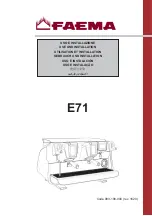
11.
Salt: Regulates Yeast Activity
Salt is necessary to control the activity of yeast, causing it to work slowly and steadily. Without salt, yeast
acts too rapidly. Salt also strengthens the structure of the dough. If too little or no salt is used, the
bread will rise rapidly and then fall. The texture will also be more coarse and/or uneven.
Sugar: Food for Yeast
Sugar is the favorite food of yeast, but too much sugar will cause the yeast to over-react. The loaf of
bread will be small and dense. Dried fruits also contribute sugar to the bread dough. We do not
recommend adding any more than is specified in each recipe. In addition, we do not recommend the
use of artificial sweeteners because the yeast cannot react with them.
SUBSTITUTES
In our test kitchen, we experimented with these ingredient substitutions. We do want to mention that
your results may vary from ours. If you would like to try other substitutions, there are several helpful
hint books available from retail stores to assist you. Of course, we cannot guarantee their results.
Eggs
Liquid egg substitutes may be used as directed on the carton.
Two egg whites may be substituted for one whole egg.
REMEMBER, all egg products must be at room temperature.
Milk
Coffee creamer, non-dairy creamer or dry buttermilk may be substituted for dry milk in equal
proportions. Liquid milk 80°F/27°C may be substituted for water in equal proportions for all bread
programs except FAST BAKE
™
. The dry milk may then be eliminated all together. The loaf will be
slightly smaller.
Salt
Salt-free recipes are not successful. Dietetically sodium free (less than 5 mg sodium per serving) or low
salt (less than
1
⁄
2
the sodium of table salt) may be used in equal amounts. The bread will be more
coarse.
Sugar
Honey may be substituted for sugar in equal proportions; reduce the liquid by the same amount.
Brown sugar may be substituted for white sugar in equal proportions. Yeast needs sugar — no artificial
sweetener should be used.
Wheat Flour
For wheat-free bread recipes refer to gluten-free bread books.
Yeast
We used RED STAR
®
Yeast to develop our recipes. However, any brand may be used. Refer to yeast
ingredient section for other yeast substitutes.
Conversion Chart for Quick-Acting Yeast
1 tsp active dry yeast =
3
⁄
4
tsp quick-acting yeast
1
1
⁄
2
tsp active dry yeast =
1 tsp quick-acting yeast
2
1
⁄
4
tsp active dry yeast =
1
1
⁄
2
tsp quick-acting yeast
1 TBL active dry yeast =
2 tsp quick-acting yeast
TBR20 Breadmaker OM-4 6/17/04 8:41 AM Page 11













































